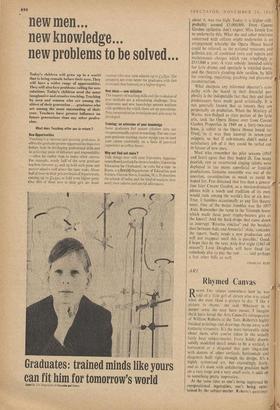AR T
Rhymed Canvas
ROGi'.R FRY relates somewhere how he was told of a little girl of eleven who was asked what she most liked a picture to do: 'I like a picture to rhyme,' she said. Whatever in a deeper sense she may have meant, I imagine she'd have loved the Arts Council's retrospective of. William Roberts at the Tate. Roberts's highly finished paintings and drawings rhyme away with fantastic virtuosity. It's the most noticeable• thing about them, after you've taken in the usually fairly busy subject-matter. Every boldly drawn. solidly modelled detail tends to be a vertical, a horizontal or a diagonal that goes ting-a-ling with dozens of other verticals, horizontals and diagonals built right through the design. It's a highly systemised art, but exceedingly lively, and as it's done with unfaltering precision both on a very large and a very small scale, it adds op to something pretty impressive.
At the same time as one's being impressed by compositional ingenuities, one's being enter- tained by the subject-matter. Roberts's paintings. as they say, are about people. People as indi- viduals, as they appear in admirably evasive portraits. Or The People generally, usually en- gaged in public leisure-pursuits. En masse, they conform to a standard pattern, with similar doll- like faces, drilled into crowded designs and painted as though by a domesticated L6ger. Roberts indulges in a certain mock-naivety in his subject-pictures which I find a pity. He has a marvellous eye for telling and curious detail, a keen observer's interest in gesture and ex- pression. But inasmuch as he makes his obser- vation humorous—and not without a touch of good-natured malice—by reducing his subjects to dolls, he condescends to them as people and lessens one's interest in them. Hence the com- pensation in terms of design. The interest he reduces on one side he whips up on the other, so the dividends come out about equal. You're never less than fully engaged by the sheer bustling energy, intelligence and industry of it all.
This is one of those overdue and eminently worthwhile retrospectives that make one ashamed one didn't know more about such an artist before. Roberts is now just seventy, by no means retired—he's had a typical eye-catcher, usually large, at every Academy since 1948—and at twenty he was exhibiting in the first Vorticist exhibition. From precociously gifted rebel to regular Academician (to be exact, Associate Academician, of all puny injustices) sounds like the decline of a Millais. But it's more like the career of a Stanley Spencer, whom Roberts in some ways resembles: that of a totally indepen- dent, idiosyncratic figurative artist using the Academy not because he's academic but because post-war art went in another direction. Roberts hasn't made the pantheon of true English originals like Spencer has, but then he's no vision- ary, and though equally brilliant as draughts- man and designer, he's more of a victim to his style—the one which makes him a pageant- master of puppets. Also, and I think this must have affected his whole career, he suffered from Wyndham Lewis's hogging the limelight.
This exhibition makes nonsense of Lewis's claim to have been the be-all and end-all of Vorticism. Roberts's work here between 1913 and about 1920 is less fantasticated than his, but to my mind shows a truer and more intelligent grasp of what Futurism was all about—the jazz age, the machine age, the social revolution, move- ment . . . and war. It's also to my mind the best part of the exhibition. The urgency of the crowded forms, all sharp angles and flickering, zig-zag rhythms, is matched by an urgency of feeling tumultuously summed up by a huge tour de force of a painting, The First German Gas Attack at Ypres, commissioned in 1918 by the Canadian War Records Office. This brilliant, baroque composition dramatises panic: perhaps, for Roberts, too much so. He could never again, in subject or style, look so emotionally involved. You could say the rest of this extraordinarily steady and consistent career is a disciplined re- treat from being the participant to being the recorder, the amused, sympathetic but essentially dispassionate observer.,That may be a presump- tuous interpretation, reading into the artist's attitude what his art in fact does to me. Obviously he's an artist whose clarity of manner shows that he would scorn emotionalism as artistic mess, and to whom energy is expressed in pre- cision. But something has been lost on the way— poetry, if you like, though it sounds a sentimental word in the context. Without it, Roberts's work is humane, vital and stimulating. But it can't catch you unawares.
DAVID THOMPSON



















































 Previous page
Previous page